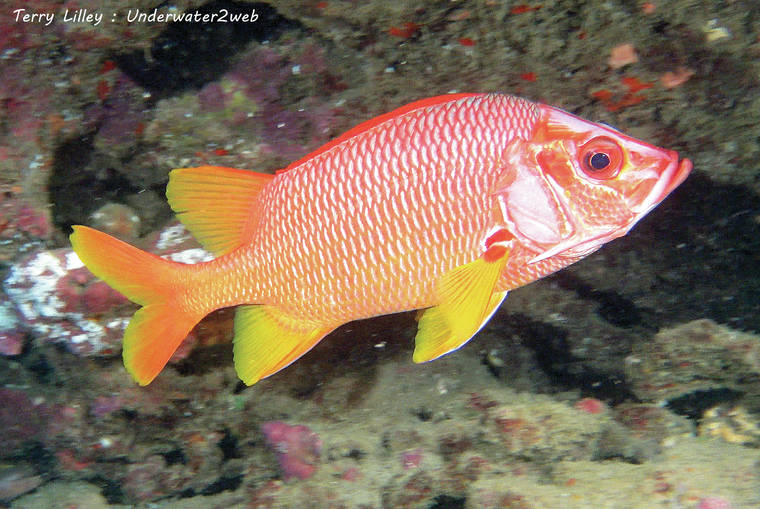This beautiful, brigh-red-and yellow, foot-long squirrel-fish with the sad-looking face is the largest type of squirrel-fish that lives in Hawai‘i. You find them most often in deep-water caves hanging out with a school of soldierfish (‘u‘u or mempachi), but they are usually by themselves, as they are quite territorial with others of their own species.
This beautiful, brigh-red-and yellow, foot-long squirrel-fish with the sad-looking face is the largest type of squirrel-fish that lives in Hawai‘i. You find them most often in deep-water caves hanging out with a school of soldierfish (‘u‘u or mempachi), but they are usually by themselves, as they are quite territorial with others of their own species.
Like most cave-dwelling fish, the ‘ala‘ihi are red because the red wavelength from the sun does not penetrate into the deep water caves, so the fish are actually jet black underwater, which helps them hide from most predators like moray eels, large ulua and sharks. These fish zoom around in the caves very quickly, feeding on shrimp and crabs, but they are also very curious, and will come out of the mouth of the cave right up to divers to take a look. In old Hawai‘i ‘ala‘ihi kalaloa was a valuable food source, but in recent times they have become so rare that fishermen rarely catch them, and most divers have never even seen one before.
Like many of our cave-dwelling fish, the long-jaw squirrel-fish has been eaten by the invasive peacock grouper (roi), which are slow-moving and like to hunt in the dark caves. The roi were brought in from Tahiti in 1953 by the state of Hawai‘i, and have now eaten up many of our cave-dwelling fish species. I have done many scuba dives in Tahiti studying the ‘ala‘ihi and roi in their native environment, and the squirrel-fish recognize the roi as a predator because they evolved with the fish on the same reef system. When a roi goes into a cave to hunt the squirrel-fish they leave the cave, but in Hawai‘i when the roi go into the cave to hunt the cave fish they just sit there and get eaten because they do not recognize the roi as a predator.
The Hawaiian name ‘ala‘ihi kalaloa means in part “long spike,” because at the base of the gill cover the fish has a venomous spine, so if a fishermen caught one and tried to hold it by putting their fingers in its gills like we do with other fish species, than the fisherman may get a very painful poke on the hand and instantly drop the fish.
You can see ‘ala‘ihi kalaloa in action in the video “The World’s Guide To Hawaiian Reef Fish” on the underwater educational web page, and be able to see movies of all the Hawai‘i reef creatures soon on our upcoming nonprofit marine science online educational program.
•••
Terry Lilley, a marine biologist, lives in Hanalei. His websites include underwater-2web.com and gofundme.com/5urrm4zw.

Subscribe today for unlimited access.
Already a subscriber?
Login
Not ready to subscribe?
Register for limited access.
If you have a print subscription but require digital access,
activate your account.


